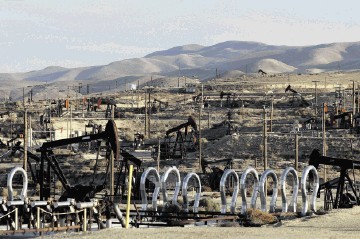
Oil’s biggest bust since the global recession was good for a few cases of whiplash.
Just two months ago, Continental Resources Inc. (CLR), the shale driller founded by billionaire Harold Hamm, budgeted for $80-a-barrel oil and planned to spend $4.6billion in 2015.
Six weeks later, with crude down 29% in the interim, Continental cut its 2015 budget to $2.7billion.
Halliburton Co. (HAL), the world’s biggest provider of fracking services to oil companies, announced December 11 that it would dismiss 1,000 workers.
Two months earlier, Chairman and Chief Executive Officer Dave Lesar said “our sector will be fine” if oil prices range between $80 and $100 a barrel.
The US shale boom that’s brought the country closer to energy self-sufficiency than at any time since the 1980s will be challenged in 2015 as never before.
The benchmark US crude price has fallen below $60, demand growth is weakening and OPEC, which controls 40% of supply, is unwilling to cut output.
“The extent and rapidity of the price decline has been a surprise,” said Andy Lipow, president of Lipow Oil Associates LLC, an energy consultant in Houston. “They’re facing a new reality.”
West Texas Intermediate reached a 2014 peak of $107.73 in June before dropping to $51.78 in electronic trading on the New York Mercantile Exchange at 12:38 p.m. Singapore time.
That’s below the break-even price for 37 of 38 US shale oilfields.
RBC Capital Markets and CIBC World Markets predict prices will remain below $60 for the first three months of 2015.
Societe Generale SA’s Michael Wittner forecasts an average of $64.50 in the first quarter and $61.50 in the second.
Some of the largest US shale drillers, such as Irving, Texas-based Pioneer Natural Resources Co. (PXD), Continental and Chesapeake Energy Corp., both based in Oklahoma City, have been spending money faster than they make it, borrowing to pay for their expansion, according financial statements filed with the US Securities and Exchange Commission.
Current oil prices are “not a sustainable long-term trend,” said Warren Henry, a spokesman for Continental. Halliburton is well positioned to handle any market environment, said Emily Mir, a company spokeswoman. Gordon Pennoyer, a spokesman for Chesapeake, declined to comment.
Representatives from Pioneer didn’t return e-mails and phone calls seeking comment.
In 2014, US oil output increased by 1 million barrels a day for the third consecutive year, pushing production to the highest in more than three decades, according to the US Energy Information Administration.
Fatih Birol, chief economist of the International Energy Agency in Paris, said December 22 that investment will decline in the US in 2015.
The 76 drillers in the Bloomberg Intelligence North America E&P Valuation Peers Index spent $184.9 billion in the 12 months through September 30, according to data compiled.
Continental, ConocoPhillips and Houston-based Apache Corp. are among the companies that have announced budget cuts.
The slump may push Texas into a “painful regional recession,” Michael Feroli, chief U.S. economist at JPMorgan Chase & Co. in New York, wrote in a December 18 report.
Texas pumps 37% of US oil output, EIA data show. The oil and gas industry accounts for 11% of the state’s economy, according to Feroli.
The effects may extend to housing and other businesses, he wrote.
The US isn’t the only place suffering whiplash. OPEC members excluding Iran are facing the lowest export revenue in a decade.
The EIA estimates OPEC will take in $446 billion this year from overseas crude shipments, from $703 billion in 2014.
OPEC has refused to cut output to boost prices, choosing to defend market share as the shale boom reduces US imports and leaves more barrels seeking alternative destinations.
Prices will rebound, Saudi Arabian Oil Minister Ali Al-Naimi said December 21 in Abu Dhabi. Suppliers from outside OPEC should cut “irresponsible” output, United Arab Emirates Energy Minister Suhail Al Mazrouei said at the same event.
The economy of Russia, the second-largest crude exporter, may contract about 4% in 2015 if oil stays at $60, according to Finance Minister Anton Siluanov.
Oil and natural gas accounted for 68% of Russia’s export revenue in 2013, according to the EIA.
Russia’s ruble dropped to a record low, echoing weakness in the currencies of other energy producers from Norway to Canada and Mexico.
The collapse in oil has also reduced costs for consumers. US drivers are paying the lowest average gasoline prices since 2009 and buying the cheapest heating oil in five years.
Goldman Sachs Group Inc. analysts said last month that cheaper US gasoline will boost economic growth by 0.5 percentage points next year.
“The benefit to consumers is a lot bigger than the hit to oil producers,” Mark Zandi, chief economist for Moody’s Analytics Inc. in West Chester, Pennsylvania, said in December 23 interview.
“If we stay at $60 a barrel, consumers will save $150 billion on gasoline. It’s huge. If history is any guide, the bulk of that money will be spent and will drive economic growth.”
